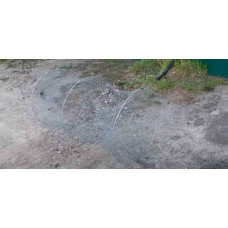From the Lithuanian vénteris, a wherry made of willow twigs.
A passive fishing gear. Belongs to the trap type. It consists of a chamber closed at the top, a yard, two wings and a central middle wing. The wing is a barrel-shaped net bag stretched over hoops and has a series of cone-shaped throats that taper backwards, allowing the fish to enter the chamber freely and making it as difficult as possible for them to return. The throat holes become smaller as the fish moves from one to the other. A distinction is made between single, double, triple, etc. according to the number of holes in the neck. They are only used to catch predatory fish in rivers and lakes during the open water period and under the ice. Fish encountering a wing perpendicular to the bank will usually turn away from the bank and most of them will enter the trap's capture zone.
It is a cylindrical net stretched over wooden or iron hoops. The first hoop, the entry hoop, is usually arched, with small weights attached to the lower ends to make it more stable. Its rear end, the cutter, through which the fish are taken, is tied and fastened to something such as a bush or, more commonly, to a specially glued stake. Each hoop (or only the front hoop, depending on size) has a net cone - a moustache - to hold the fish as they enter. From the entrance hoop, two guide wings of netting are spread out and fixed to the stakes, or two "cones" are joined together with netting fixed to the upper and lower edges of the entrance hoop (this way you can block a river or oxbow).
Venteris
Tags: Venter


